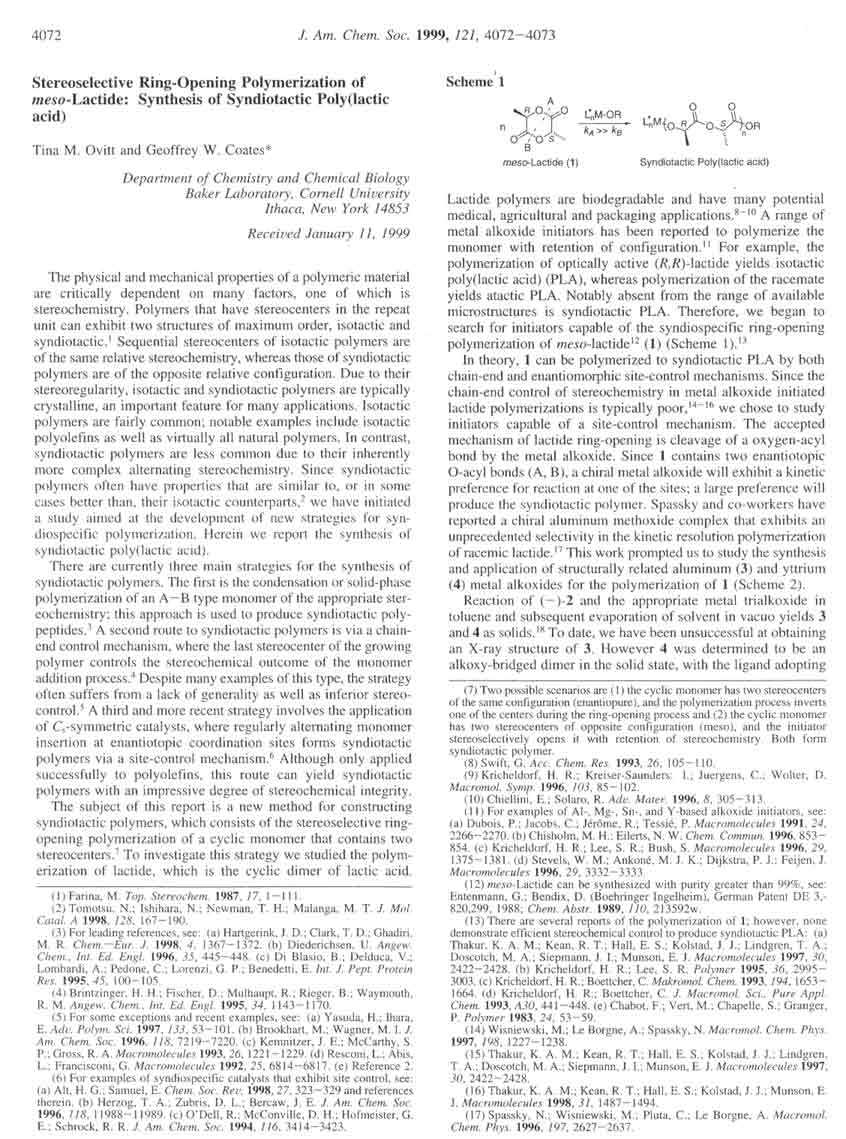PLA
Contents
PLA
Polylactic acid (PLA) is a bio-degradable polymer that can be produced from lactic acid, which can be fermented from crops such as maize. This makes it an ideal candidate for use in certain energy rich, cash poor areas of the world.
It is harder then PTFE and melts at a lower temperature (around 180°C to 220°C), so is potentially a very useful material. It does exhibit higher friction than PTFE however which can make it difficult to extrude and more susceptible to extruder jams.
For more details, see the Wikipedia entry on Polylactic acid
for chemists
A note from wikipedia:
The name "polylactic acid" is to be used with caution, not complying to standard nomenclatures (such as IUPAC) and potentially leading to ambiguity (PLA is not a polyacid (polyelectrolyte), but rather a polyester)
Usage
PLA is the ideal material for a Mendel RepRap. It is dimensionally stable, so there is no need for a heated bed. It is relatively inexpensive, and is not hard to source in filament form.
It does require some torque to move PLA through an extruder because of its higher coefficient of friction (relative to ABS), so it is recommended that you use a Geared_Nema17_Extruder or Geared_Nema17_Extruder_Driver vs the stock mendel extruder.
Heater Settings
Depending on which material you use, you should adjust your heat accordingly.
4032D requires higher temperatures and may need to be set as high as 230°C
4042D should extrude at 190°C
4043D 160-220°C around 180 is a good start(see http://ultimachine.com/pla)
Extrusion width
There has been some evidence that pigment may affect extrusion width. If you are switching plastics a lot, it is a good idea to measure the extrusion before going through the toolpath process.
Build Surface
PLA bonds very very firmly to Acrylic, and it is not recommended to print directly on an Acrylic build surface.
It does stick well and is removed easily from BlueTape
It can also be printed on Polyimide(Kapton) that is pre-heated, but will be hard to remove until both the part and the surface are cooled.
It can also be printed directly onto heated glass
PLA prints nicely directly to a lightly oiled sheet of polycarbonate/Lexan. No heat is necessary, and I have not tested it with heat. It initially sticks to polycarbonate much better than it does to blue tape, and for best results start with your Z height higher than you do with blue tape, otherwise you may have trouble getting it to release well (I use about .7mm with a .33mm layer height). If you have trouble getting it to stick, try raising your extrusion temp a few degrees. At 190C I have no trouble, but at 180C it is almost impossible to get a good first layer. With a light layer of cooking oil on the build surface, the part removes very easily once it has cooled a bit.
Moisture Issues
PLA can absorb moisture from the air. When it is heated this moisture can turn to steam bubbles which with certain hot end (extruder head) designs can interfere with printing. The symptom is that when the extruder motor stops the PLA kept coming out. When the stepper starts again there is a significant delay. Occasionally the tip may blow a bubble with a tiny puff of what looked like steam.
Small amounts of PLA filament (Natureworks PLA4043D has been tried) can have some moisture removed by putting it on a piece of aluminum foil in an oven heated to 170F for an hour. The filament in the oven is floppy, but sticks to itself only slightly. Flexing the coils after cooling unsticks them from each other. Heating a whole spool this way has not been tried, and may result in the spool becoming unusable, so caution is advised.
Interestingly, a weight change can be seen after baking. One coil went from 120.5 grams to 120.0 grams (almost 1/2%).
Availability
New Zealand
Vik Oliver (His business is Diamond Age) can supply PLA 4042D in 3mm and 1.75mm profiles in NZ. He will also ship global using 'Slow boat' (surface shipping). You can also contact him by email or IRC.
He has natural, black as well as many standard colors (blue, yellow, green) available - see the Diamond Age website for more info. If you want a custom color, and can meet a minimum order, he can source it locally.
USA
Several resellers have popped up and are supplying two different varieties of PLA
Ultimachine - http://ultimachine.com/ Green, Black, Natural 4042D in 5 lb coils
Makerbot - http://store.makerbot.com/ Natural 4032D in 1 and 5 lb coils.
Makergear - http://makergear.com/ Green, Black, Natural 4032D and 4042D in 5 lb coils and lb packs
Europe
Reprapsource - http://reprapsource.com/ PLA 4043D in different colours
2PrintBeta - http://www.2printbeta.de/ PLA 4042D in many different colours
Engineering Data
Synthesis
A crude form of PLA can be produced by simply heating powdered lactic acid with powdered stannous chloride - commonly used in pottery glazes - in a test tube. Extracting it from the test tube afterwards is left as an excercise for the diligent student.
See papers in footnote for further details.
Papers etc
- [[File:PLA-kim-23-2-6-98033.pdf: Synthesis, Characterization and in Vitro Degradation of Poly(DL-Lactide)/Poly(DL-Lactide-co-Glycolide) Films.|thumb]]
- [[File:PLA-v30 327 334.pdf: Synthesis and Characterization of Poly(L-lactide-co-ε-caprolactone) Copolymers: Effects of Stannous Octoate Initiator and Diethylene Glycol Coinitiator Concentrations|thumb]]
- [[File:PLA-DiscreteYttriumComplexesasLactidePolymerizationCatalysts.pdf: Discrete Yttrium(III) Complexes as Lactide Polymerization Catalysts|thumb]]
- Stereoselective Ring-Opening Polymerization of meso-Lactide: Synthesis of Syndiotactic Poly(lactic acid) [[
 , Page 2, Addendum|thumb]]
, Page 2, Addendum|thumb]]
- Plastics from Renewable Materials A Royal Society of Chemistry educational document giving details of how to synthesise many polymers, including PLA.